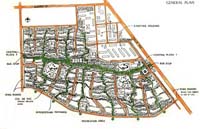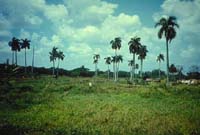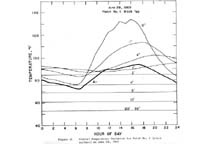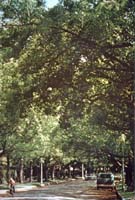Principal Concepts of the General Plan:

click on the image for a larger version.
|
Pedestrian Community
Las Arboledas is designed to be a pedestrian community which is connected to the larger urban area by bus (and auto). The pedestrian community provides an intimate social environment where children, for example, can walk to school, to the store, or to visit friends without crossing busy streets. Homes are sheltered from noise with only quiet pedestrian paths passing in front of the homes. Apartments are grouped into neighborhood clusters of about 50 apartments with public community space
in front including meeting spaces, small plazas, walkways, and green areas.
The community is connected internally by pedestrian paths and with other parts of the city by bus (or car). No through streets cross and disrupt the community. A ring road circles
the community providing easy vehicular access to and from other parts of the city. A series of finger roads provide vehicular access to the interior of the community, while protecting it from fast traffic.
|
The result is that it is easy to go from place to place within the community on foot and easy to get from the community to another part of the city by bus (or car), but it is not possible to use the community as athoroughfare. The community is a destination or a starting point, but never a passageway.
These patterns integrate both important social and energy concerns. For example, the intimate community that is created by a pedestrian circulation system also has a major impact on energy use. In California, where we have designed our towns around the car,
transportation consumes 47% of the state's energy. In Havana, 86% of the trips people make are by bus, while 6% are by car. Yet Havana's cars consume the same amount of fuel annually as the buses. In other words, the buses provide 14 times as much transportation service as the cars with the same amount of fuel.
It is critical, both in industrialized countries and in developing countries, to provide alternatives to the automobile and to demonstrate convenient and efficient transportation designs which also provide a healthy social environment.
Lively Town Centers
There are two centers for the community, one for each 10,000 people. The centers consist of a central plaza surrounded by the community services: market, pharmacy, cafeteria, meeting rooms, social area, etc. In a typical Cuban community these services are normally very minimal. We are proposing ways to increase the intensity of activity at low cost, in particular by including outdoor and semi-outdoor activities. For this purpose we have incorporated a farmer's market and an open air cinema into the community center.
The two community centers are linked by a pedestrian boulevard along which are placed the schools, playgrounds, and certain other lower intensity public uses as well as some housing. The centers are close to a bus stop and the major street to central Havana. In this way, most people will pass through or close to the central plaza on their way to and from other parts of the city, on their way home from work, returning from shopping in the city center, etc.
Preservation of the Local Environment

click on the image for a larger version.
|
The site is quite beautiful with numerous large trees, mango orchards, and rolling hills. One of our objectives is the preservation of this landscape and its integration with the new community.
A plan which has accommodated the trees and natural topography of a site, is automatically in closer touch with the site and has accounted for a number of factors which might otherwise go overlooked. This constraint alone forces better and more sensitive design.
|
However, in discussing the value of the natural landscape, we often think in aesthetic terms and these concerns can seem small in the face of the bulldozer. Builders often prefer to clear all the trees and level the ground, especially when heavy equipment is used, arguing that it is cheaper. Since we feel that destruction of the natural environment is in fact a gross economic error, we have pointed out some of the more concrete benefits of preserving it.
Microclimate: Landscaping for Energy Savings
 click on the image for a larger version.
click on the image for a larger version.
 click on the image for a larger version.
click on the image for a larger version.
 Figure 6
Figure 6
click on the image for a larger version.
|
In Cuba's tropical climate, buildings can become very hot and uncomfortable. As people's incomes rise, they will attempt to provide air conditioning for hot buildings. This can be a large energy consumer that not only increases the environmental problems associated with energy use, but competes with more basic economic development for energy resources. One of our objectives has been to design buildings that are naturally cool and thereby eliminate this potential energy drain.
The landscape can play an important role in cooling buildings and in creating a more comfortable microclimate. Part of this effect is illustrated rather clearly in a series of tests done by the U.S. National Bureau of Standards in the southern U.S. (NBS Report 10373, February 1, 1971) These tests measured the surface temperatures of a blacktop surface and a grass covered surface during the 24 hours of the day. On a summer afternoon, when the air temperature had risen to 90 degrees, the surface of the blacktop had risen to over 130 degrees. In addition it stored this heat and so remained hotter than the surrounding air even during the night. In contrast, a grass covered surface nearby barely reached 90 degrees at its hottest and during most of the day and night was more than 12 degrees cooler than the surrounding air. Figure 6, shows the average monthly temperatures throughout the year for the blacktop surface, the grass surface, and the surrounding air. The blacktop is consistently hotter than the air, while the grass is consistently cooler. During the summer the grass was more than 10 degrees cooler than the blacktop. In fact it is well known that cities, with these asphalt "solar collectors", are hotter than the surrounding rural areas.
|
Shaded Streets

click on the image for a larger version.
|
Trees and plants are important in creating and maintaining a thermally comfortable environment. These particular tests suggest that we should minimize paved surfaces. But we cannot eliminate them entirely, so what can we do? One answer is to shade the streets with large trees. But these trees cost money to plant and maintain. In addition they can easily take 20 years or more to reach the required size. But our site already has many large trees with a great value, all we have to do is preserve them. This then is one of many motives for taking care of the existing natural setting.
|

· home · projects · bulletin board · links · who are we · contact ·
webdesign by Ari Goldstein
|

